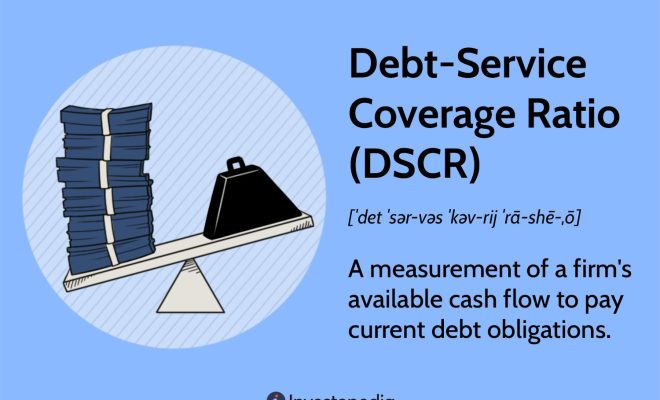How to calculate debt coverage ratio

The debt coverage ratio (DCR), also known as the debt service coverage ratio (DSCR), is a valuable financial metric for assessing a company’s or individual’s ability to repay their existing debt obligations. A higher DCR indicates a better financial position, as it signifies that the company has sufficient cash flow to cover its debt payments. It’s a crucial tool lenders and investors use to evaluate risk when lending money or investing in businesses. In this article, we’ll explore how to calculate the DCR, its importance, and how to interpret the results.
Step-by-Step Process of Calculating the Debt Coverage Ratio
1. Gather Relevant Financial Data
The first step in calculating the DCR is obtaining the essential financial information, which includes:
– Net Operating Income (NOI): The total revenue generated by business operations minus operating expenses.
– Total Debt Service (TDS): The sum of all principal and interest payments on all outstanding debts during a specific period.
2. Calculate Net Operating Income (NOI)
To calculate NOI, follow this formula:
NOI = Revenue – Operating Expenses
Operating expenses include costs such as rent, utilities, salaries and wages, but exclude taxes, depreciation, amortization, and interest payments on loans.
Example:
Revenue: $500,000
Operating Expenses: $250,000
NOI = $500,000 – $250,000
NOI = $250,000
3. Calculate Total Debt Service (TDS)
Next, you’ll need to calculate TDS by summing up all principal and interest payments on your loans.
Example:
Loan 1 monthly payment: $2,000 (including principal and interest)
Loan 2 monthly payment: $1,500 (including principal and interest)
TDS (Annual) = ($2,000 + $1,500) x 12
TDS = $42,000
4. Calculate Debt Coverage Ratio (DCR)
Finally, divide the NOI by the TDS to get the DCR.
DCR = NOI / TDS
Example:
$250,000 (NOI) / $42,000 (TDS) = 5.95
Interpreting and Using the Results
A DCR of 1 or higher means that a company or individual can pay their debt without any financial strain. Here’s a general guideline for interpreting DCR outcomes:
– DCR < 1: The cash flow is not sufficient to cover debt payments, indicating a higher risk of default.
– DCR = 1: The cash flow is equal to debt payments, suggesting that there’s no additional buffer for unexpected expenses or downturns in revenue.
– DCR > 1: The excess cash flow implies a lower risk of default and better financial stability.
For lenders and investors, a higher DCR signifies lower credit risk, making it easier for companies and individuals to obtain loans or attract investments. For businesses and individuals alike, maintaining a healthy DCR is vital for long-term financial health and growth opportunities.
Conclusion
Understanding and calculating the debt coverage ratio is critical to evaluating an entity’s ability to service its debt obligations. It enables businesses, lenders, and investors to assess creditworthiness more accurately and make informed credit and investment decisions. By maintaining a strong DCR, companies and individuals can increase their likelihood of securing favorable loan terms or attracting new investments while minimizing their risk of financial distress.






